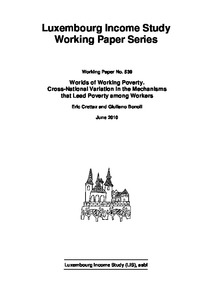Worlds of working poverty, cross-national variation in the mechanisms that lead poverty among workers
"The objective of this paper is to distinguish between different types of working poverty, on the basis of the mechanisms that produce it. Whereas the poverty literature identifies a myriad of risk factors and of categories of disadvantaged workers, we focus on three immediate causes of working...
| Main Authors: | , |
|---|---|
| Institution: | ETUI-European Trade Union Institute |
| Format: | TEXT |
| Language: | English |
| Published: |
Luxembourg
2010
LIS |
| Subjects: | |
| Online Access: | https://www.labourline.org/KENTIKA-19183652124919018349-Worlds-of-working-poverty,-cro.htm |
| Summary: | "The objective of this paper is to distinguish between different types of working poverty, on the basis of the mechanisms that produce it. Whereas the poverty literature identifies a myriad of risk factors and of categories of disadvantaged workers, we focus on three immediate causes of working poverty, namely low wage rate, weak labour force attachment, and high needs, the latter mainly due to the presence of children (and sometimes to the increase in needs caused by a divorce). These three mechanisms are the channels through which macroeconomic, demographic and policy factors have a direct bearing on working households. The main assumption tested here is that welfare regimes strongly influence the relative weight of these three mechanisms in producing working poverty, and, hence, the composition of the working-poor population. Our figures confirm this hypothesis and show that low-wage employment is a key factor, but, by far, not the only one and that family policies broadly understood play a decisive role, as well as patterns of labour market participation and integration." |
|---|---|
| Physical Description: | 17 p. Digital |

